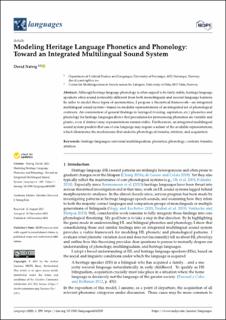Modeling Heritage Language Phonetics and Phonology: Toward an Integrated Multilingual Sound System
Peer reviewed, Journal article
Published version
Permanent lenke
https://hdl.handle.net/11250/2835058Utgivelsesdato
2021-12Metadata
Vis full innførselSamlinger
Originalversjon
Natvig, D. (2021) Modeling Heritage Language Phonetics and Phonology: Toward an Integrated Multilingual Sound System. Languages, 6(4), 209 10.3390/languages6040209Sammendrag
Although heritage language phonology is often argued to be fairly stable, heritage language speakers often sound noticeably different from both monolinguals and second-language learners. In order to model these types of asymmetries, I propose a theoretical framework—an integrated multilingual sound system—based on modular representations of an integrated set of phonological contrasts. An examination of general findings in laryngeal (voicing, aspiration, etc.) phonetics and phonology for heritage languages shows that procedures for pronouncing phonemes are variable and plastic, even if abstract may representations remain stable. Furthermore, an integrated multilingual sound system predicts that use of one language may require a subset of the available representations, which illuminates the mechanisms that underlie phonological transfer, attrition, and acquisition.

